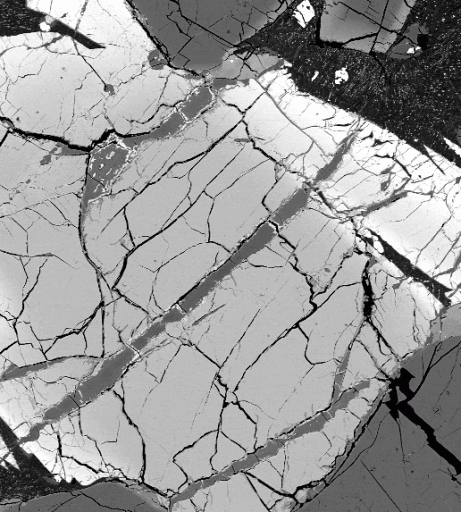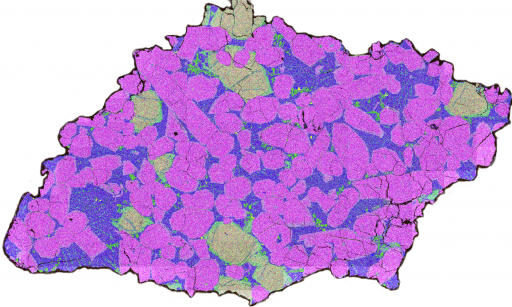Astrobiologists find Martian clay contains chemical implicated in the origin of life
June 12, 2013

Electron microscope image showing the 700-million-year-old Martian clay veins containing boron (100 µm = one tenth of a millimeter) (credit: UHNAI)
Researchers from the University of Hawaii at Manoa NASA Astrobiology Institute (UHNAI) have discovered high concentrations of boron in a Martian meteorite.
When present in its oxidized form (borate), boron may have played a key role in the formation of RNA, one of the building blocks for life. The work was published on June 6 in open-access PLOS One.
“Borates may have been important for the origin of life on Earth because they can stabilize ribose, a crucial component of RNA. In early life RNA is thought to have been the informational precursor to DNA,” said James Stephenson, a UHNAI postdoctoral fellow.
RNA may have been the first molecule to store information and pass it on to the next generation, a mechanism crucial for evolution.
Although life has now evolved a sophisticated mechanism to synthesize RNA, the first RNA molecules must have been made without such help. One of the most difficult steps in making RNA nonbiologically is the formation of the RNA sugar component, ribose. Previous laboratory tests have shown that without borate the chemicals available on the early Earth fail to build ribose. However, in the presence of borate, ribose is spontaneously produced and stabilized.
On our planet, borate-enriched salt, sediment and clay deposits are relatively common, but such deposits had never previously been found on an extraterrestrial body.
This new research suggests that when life was getting started on Earth, borate could also have been concentrated in deposits on Mars.
The significance goes beyond an interest in the red planet, as Hallis explains: “Earth and Mars used to have much more in common than they do today. Over time, Mars has lost a lot of its atmosphere and surface water, but ancient meteorites preserve delicate clays from wetter periods in Mars’ history.
“The Martian clay we studied is thought to be up to 700 million years old. The recycling of the Earth’s crust via plate tectonics has left no evidence of clays this old on our planet; hence Martian clays could provide essential information regarding environmental conditions on the early Earth.”
The presence of ancient borate-enriched clays on Mars implies that these clays may also have been present on the early Earth. Borate-enriched clays such as the ones studied here may have represented chemical havens in which one of life’s key molecular building blocks could form.
UHNAI is a research center that links the biological, chemical, geological, and astronomical sciences to better understand the origin, history, distribution, and role of water as it relates to life in the universe.
